1. Teapot Dome Service Station – Zillah, Washington
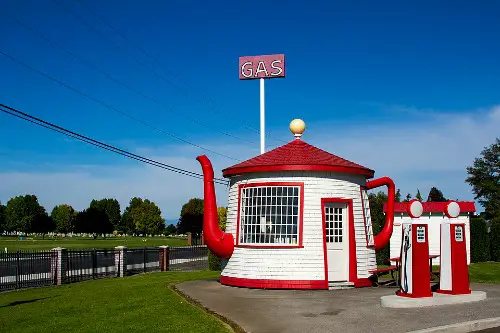
Shaped like a squat white teapot with a bright red spout, this 1922 gas station is a nod to the Teapot Dome political scandal of its era. The handle and spout are more than decorative—they’re part of the building’s structure. It’s a playful blend of function and satire that drew motorists off the road for fuel and a laugh. The building now serves as a quirky historical stop rather than a working station.
Its round walls and whimsical proportions make it look like a set piece from a children’s storybook. The political reference might have faded from popular memory, but the visual gag hasn’t lost its charm. It’s proof that even something as utilitarian as a gas station can have personality. And in this case, that personality comes with a smirk.
2. Binoculars Building – Los Angeles, California
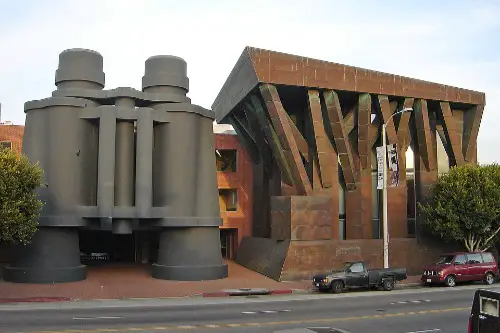
In Venice Beach, a pair of massive black binoculars mark the entrance to an office complex designed by Frank Gehry and Claes Oldenburg. The lenses form a tunnel you can literally drive through to park. From the street, it looks less like an office building and more like public sculpture dropped in the middle of the block. It’s part of a larger postmodern structure with playful angles and textures.
The binoculars don’t just announce the building—they define it. It’s a rare example of a corporate space that embraces humor and curiosity. Walking past feels like being stared at, but in the friendliest way possible. It’s architectural personality turned up to eleven.
3. The Big Duck – Flanders, New York

Built in 1931 to sell poultry and eggs, this roadside wonder is shaped exactly like a giant duck, complete with beady eyes and a rounded bill. It’s so famous that architects actually coined the term “duck” to describe buildings whose shapes hint directly at their purpose. For decades, it’s been a beloved stop for travelers heading to the Hamptons. Today, it serves as a visitor center, keeping its feathered legacy alive.
There’s no missing it—nestled beside the road, it feels like a cartoon plopped into real life. The simplicity makes it both hilarious and strangely elegant. It’s the kind of structure that makes drivers slow down just to point and smile. Few buildings can pull off both history and pure whimsy quite like this one.
4. Lucy the Elephant – Margate, New Jersey

Towering six stories high, Lucy has been watching over the Jersey Shore since 1881. Originally built to promote local real estate, the hollow wooden elephant has also served as a tavern, summer home, and observation deck. Painted in shades of gray with colorful trim, she stands as one of the oldest examples of novelty architecture in the country. Visitors can climb up into her howdah for a sweeping ocean view.
Lucy is equal parts absurd and majestic. There’s something delightfully improbable about walking into an elephant’s belly to buy a souvenir. Her presence feels both whimsical and deeply rooted in coastal history. She’s a reminder that architecture doesn’t always have to take itself seriously.
5. Longaberger Basket Building – Newark, Ohio

At first glance, you might think you’ve stumbled across the world’s biggest picnic basket—and you’d be right. This seven-story structure was built as the headquarters for the Longaberger Company, complete with massive steel handles stretching skyward. Every detail mimics the weave of an actual basket, down to the warm beige coloring. It’s a literal case of a company wearing its product on its sleeve—or in this case, its roof.
The sheer scale makes it surreal, almost like a Photoshop trick come to life. Sunlight catches the curves and weaves just like it would on a picnic table. It’s playful branding on a skyscraper scale, and it still inspires countless road trip detours. Even in retirement from corporate life, it’s unforgettable.
6. Shoe House – Hallam, Pennsylvania
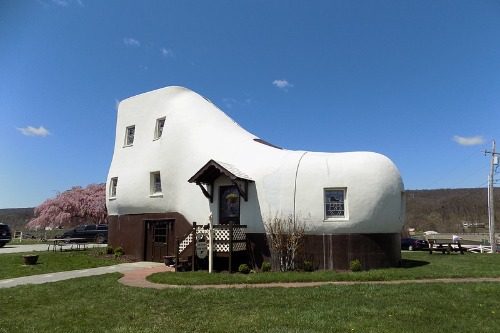
Shaped like a giant work boot, this five-story house was built in 1948 by a shoe salesman with a flair for marketing. Complete with lace-hole windows and a leather-brown exterior, it looks like it walked straight out of a nursery rhyme. The interior has multiple levels, each tucked into the curve of the boot. Today, it serves as a museum celebrating its quirky history.
It’s hard not to grin when you see it from the road—it’s as if a cobbler’s daydream became real estate. The boot’s unusual shape creates unexpected nooks and angles inside. While the idea was born from advertising, it’s since become pure Americana. A home you can quite literally “walk” into.
7. Chet Holifield Federal Building – Laguna Niguel, California
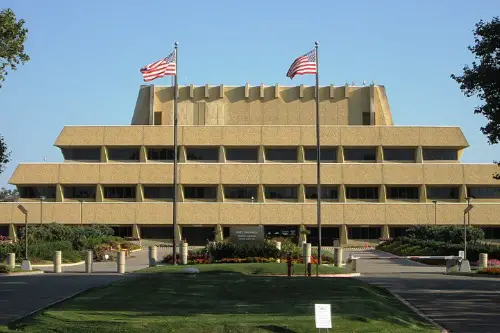
From a distance, this government building could be mistaken for an ancient stepped temple. Built in 1971, its tiered design was inspired by Mesopotamian ziggurats, though it’s made entirely of modern concrete. The sloping, stacked layers make it look more like a lost monument than an administrative hub. Inside, it’s filled with offices for federal agencies.
The effect is striking—solemn, imposing, and completely out of place in suburban California. Its geometric symmetry draws the eye upward, even if the work done inside is decidedly down-to-earth. It’s the kind of building that tricks you into expecting a ceremonial procession instead of a security checkpoint. In short, it’s bureaucracy dressed as ancient grandeur.
8. Substations Disguised as Houses – Washington, D.C., and beyond
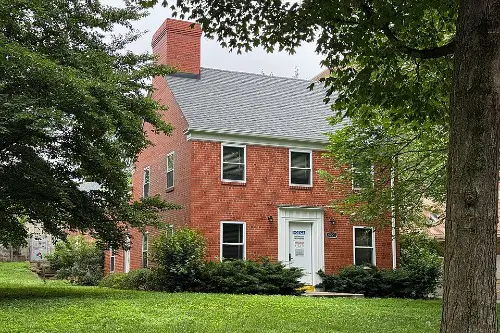
Scattered through American cities, some power substations are built to look like regular houses or barns. From the sidewalk, they have porches, windows, and chimneys—though none of them actually function as homes. This camouflage is meant to blend industrial infrastructure into residential neighborhoods. The result is equal parts practical and uncanny.
Once you realize what you’re looking at, the illusion can feel almost eerie. These buildings hum quietly behind their fake façades, hiding transformers instead of living rooms. They’re an architectural sleight of hand that most people never notice. Perfectly ordinary—until they’re not.
9. Mather Tower – Chicago, Illinois
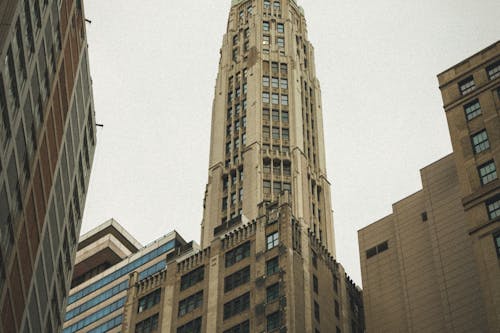
The slender Mather Tower is topped with an octagonal crown that looks like an oversized spyglass balanced on its roof. Built in 1928, the unusual cap narrows so sharply that it feels like the building is trying to disappear into the sky. Its style blends Gothic and Art Deco details with a dash of oddity. From certain angles, the tower’s proportions look almost surreal.
It’s one of those skyline features that makes you look twice, unsure if you’re seeing it right. The unexpected geometry feels playful, even in the midst of Chicago’s serious high-rises. Its tapering peak adds a sense of movement, as if the building is stretching upward. A skyscraper with a little mystery at the top.
10. Kansas City Public Library Parking Garage – Kansas City, Missouri
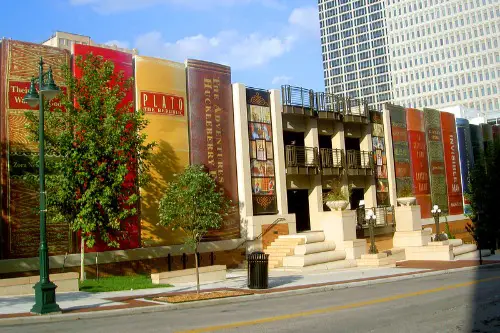
Here, the facade of a parking garage has been transformed into a row of towering book spines. Each “book” is a panel painted to resemble a classic title chosen by community members. The effect is a streetscape that feels like a giant bookshelf waiting to be read. It’s a smart way to turn an otherwise bland structure into public art.
Walking past feels like browsing an open-air library. The playful scale makes familiar titles feel monumental. It turns parking into an act of culture rather than pure necessity. A quiet celebration of reading—on a very loud scale.
11. Milk Bottle Grocery – Oklahoma City, Oklahoma
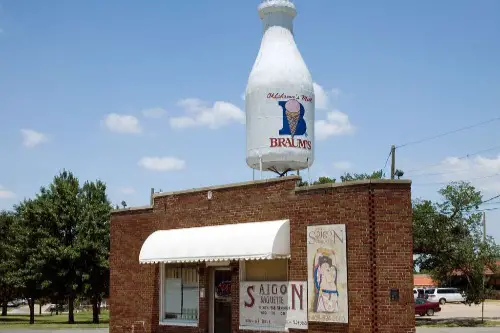
Perched on the roof of a small brick building, a giant metal milk bottle announces itself from blocks away. Installed in 1930, it originally advertised a local dairy, though the shop beneath has changed hands many times. The bottle is painted white with red lettering, making it look fresh from the fridge. Over the years, it’s become a nostalgic roadside landmark.
There’s a cheerful honesty to its design—it’s exactly what it says it is. The oversized prop turns an ordinary corner store into something memorable. Even in a world of neon and billboards, a milk bottle this big still stands out. It’s advertising as architecture at its most charming.
12. Twistee Treat Ice Cream Stands – various U.S. locations
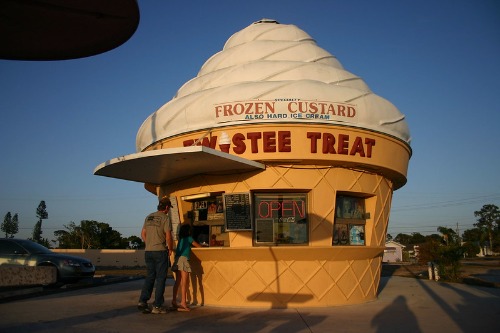
These small shops are shaped like soft-serve cones, complete with swirls, ridges, and a cherry on top. First appearing in the 1980s, they made it impossible to mistake what was being sold inside. The design is simple, but the effect is instant: a cone you can walk into. They’ve become beloved summer sights in many states.
The exaggerated scale makes them feel like a pop-art sculpture dropped on a street corner. Their cheerful colors and cartoonish shapes practically guarantee a smile. It’s branding so effective you can spot it from a mile away. Dessert, served in architectural form.
13. Cabazon Dinosaurs – Cabazon, California
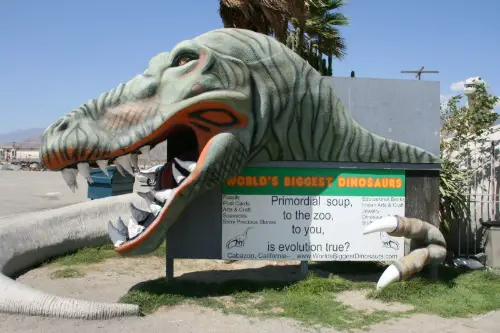
Two massive concrete dinosaurs—a brontosaurus and a T. rex—stand along the desert highway, one of them housing a gift shop inside. Built in the 1960s and ’80s, they were intended to lure travelers off the road for food and souvenirs. Over the years, they’ve appeared in films, TV, and countless road trip photos. They’re equal parts sculpture, building, and billboard.
Standing at their feet feels like stepping into a roadside time warp. The dinosaurs’ sheer size makes them absurd, yet strangely endearing. Whether you love kitsch or prehistoric creatures, they’re impossible to ignore. Sometimes, the best landmarks are the ones that make no practical sense at all.
This post 13 U.S. Buildings That Were Designed to Look Like Other Buildings and Confuse Everyone was first published on American Charm.


